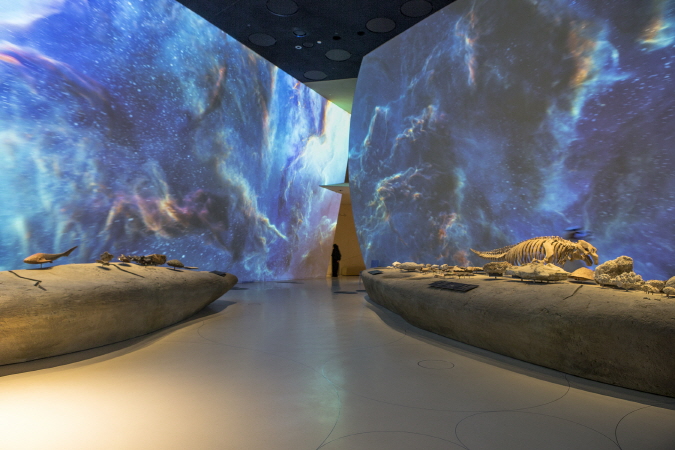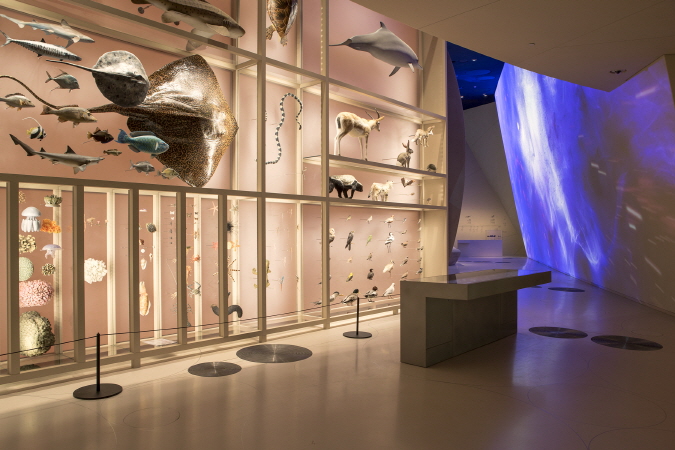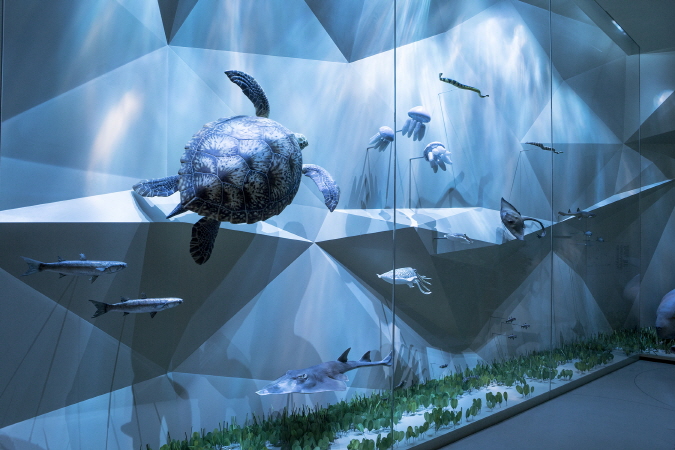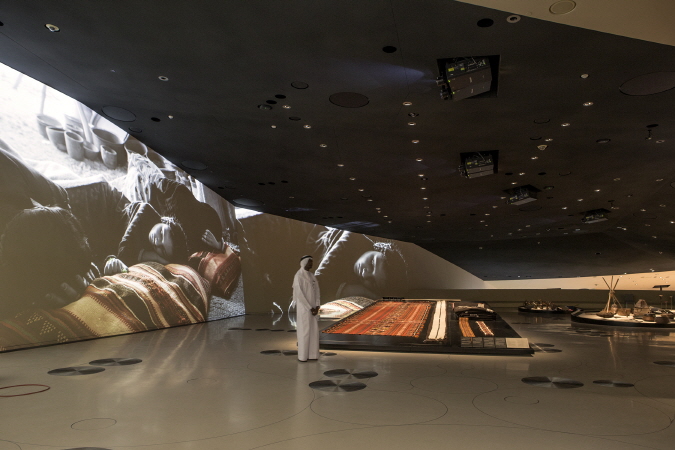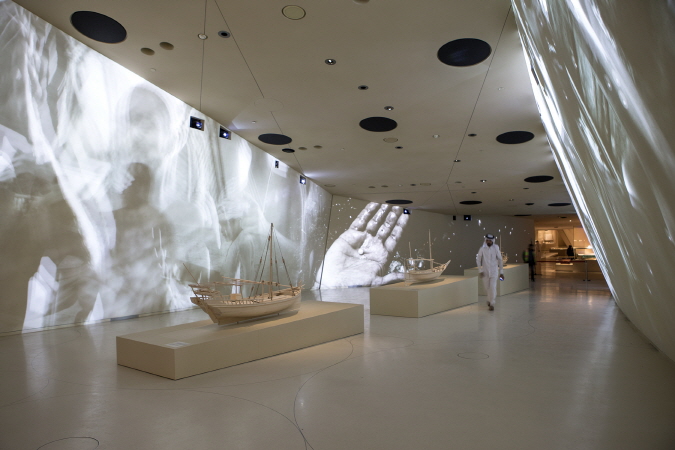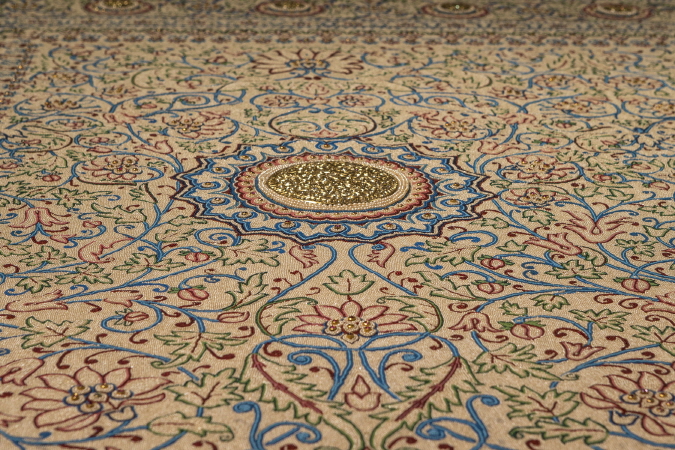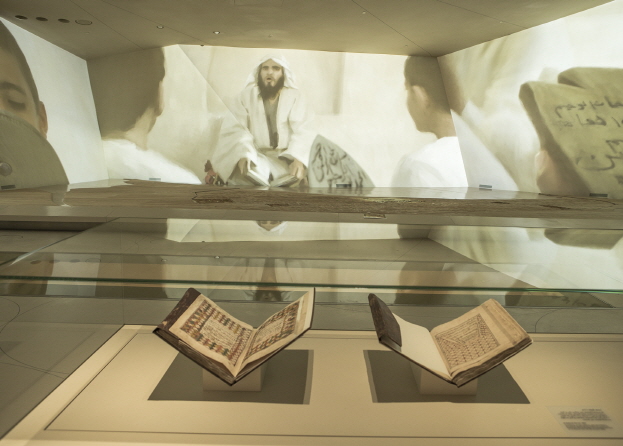AD
●●● 멋진 세상 속 건축디자인_ 사막의 장미(The Desert Rose)라는 자연 응결체를 모티브로 한 ‘카타르 국립박물관(National Museum of Qatar)’… 76,000장의 섬유 콘크리트 패널 조각을 정교하게 맞춰 구현한 316개의 원형 디스크판의 조합, 옛 왕궁과 조화를 이루며 과거와 현재를 하나로 잇는 비정형 뮤지엄건축의 수작
Qatar is an ancient land, rich in the traditions of life in the desert and by the sea. It is also a country whose modern history has been defined by oil, with all the dramatic change that its discovery brought. Today, as we enter a new era, Qatar’s trajectory onto the contemporary world stage has been just as rapid. Already we are in the vanguard of technological advance and are preparing, through the ambitious 2030 Qatar National Vision, an outward-facing, creative and sustainable future for all our people. But a future must grow out of an understood and integrated past. So, as we move forward, we are focusing strongly on culture, in diverse forms. We are delving into our Arab heritage while also exploring the arts as they are evolving today, both within Qatar and far beyond. In particular, we are encouraging our own young artists, many of whom are women. They are drawing on the unique perspective that their place in the global village allows them. At the same time they are looking to connect, ever more strongly, with their peers across the world, and in this we are supporting them. Culture connects people, and through international festivals, our new museums and an array of programmes for exploration and exchange, the arts in Qatar are both growing organically from within, and reaching out across the seas. The National Museum of Qatar supports our ambition to celebrate the local in the global, the global in the local, and all our shared humanity.
A visit to the National Museum of Qatar is an all-encompassing journey, carrying you from millions of years ago to the edge of tomorrow. The journey sweeps you across the inland desert, and plunges you into the depths of the sea. It embeds you among nomadic poets and artisans, and ushers you into today’s gleaming towers and bustling refineries. Music, storytelling, commissioned artworks, ancient artifacts, rare and precious objects, and dazzling, monumental films are all part of the experience, which combines wide-ranging scholarship with the authentic faces and voices of the people of Qatar—the true source and inspiration for this museum. Just as the museum itself is a journey, so too was the process that led to its creation. Qatar Museums and the National Museum team felt strongly that we wanted to create a living experience for our people—a museum with a heart. That meant, first of all, that our galleries should be full of movement, sound, colour, and a sense of discovery. We believed we had the potential to go beyond even the most exciting existing museum displays and develop something truly immersive. And we believed the substance of those experiences ought to come from the Qatari people themselves. So we began a decade of planning and organizing. To develop our ideas about the form that our exhibitions might take, we visited institutions throughout the world, surveying the most advanced, engaging displays of history, natural history, and art. To develop the content of NMoQ, we began to organize meetings with the public, inviting Qataris to share whatever stories and materials they might care to offer.
We asked them to tell us what they most wanted to see and hear in NMoQ. We held more than a dozen of these meetings, which were attended by more than 400 people. Out of them came a richness of information—of life—that became the essence of NMoQ. Our next step was to distill this essence into themes that would run through the museum. We imagined the special combination of space, sights, sounds, and materials that would carry our visitors along— including the artworks and films we could commission to help tell our story. At the same time, we were gathering scholarly insights and information from our local and international network of subject specialists. The depth of knowledge from these partners helped us shape the adventure in museum-going that was beginning to emerge. To test our ideas, one of our earliest initiatives was to organize a pilot project, telling the story of the historic Palace of Sheikh Abdullah: the former home of the ruler and seat of government, and the original site of the National Museum.
To discover how our themes and methods would resonate with people, we presented a three-month-long exhibition about the Palace. When 11,000 people came to visit and told us how much it meant to them, we knew we were on the right path. Working hand-in-hand with our outstanding design team, we continued to give the new NMoQ its astonishing reality. Every element of the museum that took shape, inside and out, became a reflection of the lives and aspirations of the Qatari people. The magnificent architectural design by Jean Nouvel, which like the desert rose seems to grow out of the landscape, enfolds the beloved, renovated Palace of Sheikh Abdullah bin Jassim as the very core of the new Museum. Commissioned artworks by local and international artists—Ali Hassan, Aisha Nasser Al-Sowaidi, Roch Vandromme, Jean-Michel Othoniel, and more—add a variety of highly personal visions to our themes. The result is a museum that tells a story in three overarching chapters—Beginnings, Life in Qatar, and The Modern History of Qatar—divided into eleven sections. Each section is a distinctive, 360-degree environment, which brings you into the heart of its theme.
You encounter the natural habitat and wildlife of Qatar through a kaleidoscopic visual experience by filmmakers Christophe Cheysson and Jacques Perrin. You meet the people of Qatar and begin to learn about their traditional way of life through filmed oral histories, selected from more than 500 that we recorded, and authentic artifacts salvaged from a ship that sank a thousand years ago. The gallery about life in the desert centers on a complete bait al-sha’r, or nomads’ tent, accompanied by a breath-taking film by the great director Abderrahmane Sissako, starring the actual family to whom the tent belonged. The presentation about contemporary life and today’s liquid natural gas production includes a grand-scale model of Doha itself, a multi-user interactive wall for calling up information and images, and a 30-screen video installation by John Sanborn. With all this, and more, the museum we have created is not a showcase for a collection. It is a journey—and like any true journey, it does not merely take people from one place to another. It changes the travellers themselves and helps redefine them. I hope that everyone who joins in the journey of the National Museum of Qatar will be moved by the experience. I hope they will come out with a deeper understanding of life in this ancient and modern land, and a greater sense of wonder at all it offers the world.
The National Museum of Qatar emerges from a desert that has ventured all the way to the sea. On the site, the Royal Palace of Sheikh Abdullah bin Jassim Al Thani rises up, a twentieth-century landmark of major heritage value to Qatar. The National Museum is dedicated to the history of Qatar. Symbolically, its architecture evokes the desert, its silent and eternal dimension, but also the spirit of modernity and daring that have come along and shaken up what seemed unshakeable. So it’s the contradictions in that history that I’ve sought to evoke here. Qatar is also about the peoples who settled along the seaboard, setting up these coastal towns that became ports of call for passing nomads as much as local fishermen and pearl divers. And so the native fauna and flora, and the nomadic peoples and their long-held traditions, are the very first features of the history of Qatar. Three economic miracles occurred to shake up this overwhelming tranquillity.
The first, dating from Roman times, was associated with pearl fishing and the pearl trade. The second, in the aftermath of the Second World War, was the amazing discovery of oil, followed twenty years later by the discovery of another treasure: gas. The desert peninsula of Qatar and its people suddenly saw enormous, dazzling change and the country turned into a real crossroads, alluring and open, and attracting visitors from far and wide. The building I designed needed to reflect these three different stories. The first, which covers a long period, is the story of the peninsula and its inhabitants. The second is an exploration of the coastal and desert lifestyles as well as the pearling industry, and third covers the spectacular acceleration that gave the kingdom – in just a few decades – the power and prosperity we associate with it today. Because of its economic power, Qatar has become a world leader in fields as diverse as education, communications, and energy technology. The desert rose, a flower-like aggregate of mineral crystals occurring only in arid coastal regions, is the first architectural structure that nature itself creates, through wind, sea spray and sand acting together over millennia. It’s surprisingly complex and poetic. Taking the desert rose as a starting point turned out to be a very progressive, not to say utopian, idea. I say ‘utopian’ because, to construct a building 350 metres long, with its great big inward-curving disks, and its intersections and cantilevered elements – all the things that conjure up a desert rose – we had to meet enormous technical challenges. This building is at the cutting-edge of technology, like Qatar itself. The museography that grew out of this specific history and these specific considerations provides an experience that’s architectural, spatial and sensory all at once. Inside, you find spaces that don’t exist anywhere else in the world since it’s the interlocking of all these disks that forms the building, inside and out. The result is a construction made of geometric spaces. I owe my love of things that aren’t quite vertical to one of my teachers and mentors, Claude Parent, with whom I worked a great deal. A number of floors are on an incline. You walk under them, you walk up, and you become aware that there are hardly any vertical lines anywhere. Looking more closely, you can find a few elements that appear to be vertical but, in reality, are not. You only get the impression they are because that’s the natural scheme of things.
The museum occupies a vast area. From the moment you step inside you’re struck by the relationship between the form and the scale, between the theme and the different eras dealt with… between the small desert rose that comes down to us from out of the mists of time and this outsize creation. As for the desert, it’s always there, even if it has morphed into something else completely. As you walk through the different volumes, you never know what’s coming next in terms of the architecture. The idea was to create contrasts, spring surprises. You might, for instance, go from one room closed-off pretty high up by a slanting disk to another room with a much lower intersection. This produces something dynamic, tension. As in a lot of other museums, the circuit forms a loop. The complete tour takes about two hours and ends in discovery of the old Royal Palace, which has been restored. From certain points, you can access the Baraha. Following the time-honoured template, this is a central courtyard surrounded by buildings where travellers would come and unload their merchandise. The Baraha gives an idea of the scale of the Royal Palace. It’s a sheltered space, with the museum built around it. Thanks to disks tilted at different angles, it also offers shade. This space can accommodate outdoor events, performances, theatre pieces, events connected to the exhibitions. The Baraha is also connected to the outdoor spaces of the old palace. From there, you can stroll along a promenade at the water’s edge. I wanted to create a structure that evoked the local geography and, in keeping with the tradition of the place, to ensure that it offers maximum protection from the sun. The building is extremely energy efficient. The disks that make up its structure are heavy and form a sort of cushioned barrier that acts as a sunscreen. When the sun hits the building from east or west, the disks cast long protective shadows. The building doesn’t have a lot of openings, and the few windows it does have are set back so that they’re always out of reach of the sun. The interior spaces can be air conditioned more economically as a result. The skin of the building is made of high-performance glass fibre-reinforced concrete that’s the same sandy beige colour inside and outside the building. As for the museography, I have worked in close collaboration with the National Museum to launch the opening with a series of films that provide glimpses of different aspects of Qatar and its history. Made by filmmakers and video artists handpicked for their talent as creators of evocative poetic images, these films are sensitive testaments to past eras. They will never be shown anywhere else, as they’ve been made specifically for the museum and formatted to fit the shape and scale of the walls they’re screened on. The films translate the way the architecture is tailored to the expression of a museograph specifically designed to evoke the scale and power of the land and history of Qatar, from time immemorial to the present moment.>Architects_ Atelier Jean Nouvel, Architect in Charge_ Jean Nouvel, 자료_ AJN, National Museum of Qatar, Photo by Iwan Baan(Exterior), Danica O. Kus(Interior), 기사 출처_ 에이앤뉴스 AN NEWS(ANN NEWS CENTER) 제공
안정원(비비안안 Vivian AN) 에이앤뉴스 발행인 겸 대표이사, 한양대학교 실내건축디자인학과 겸임교수
제공_ 에이앤뉴스그룹 ANN(에이앤뉴스_ 건축디자인 대표 신문사 ‧ 에이앤프레스_건설지, 건설백서, 건설스토리북, 건설엔지니어링북 전문출판사)
[저작권자(c) YTN 무단전재, 재배포 및 AI 데이터 활용 금지]
Qatar is an ancient land, rich in the traditions of life in the desert and by the sea. It is also a country whose modern history has been defined by oil, with all the dramatic change that its discovery brought. Today, as we enter a new era, Qatar’s trajectory onto the contemporary world stage has been just as rapid. Already we are in the vanguard of technological advance and are preparing, through the ambitious 2030 Qatar National Vision, an outward-facing, creative and sustainable future for all our people. But a future must grow out of an understood and integrated past. So, as we move forward, we are focusing strongly on culture, in diverse forms. We are delving into our Arab heritage while also exploring the arts as they are evolving today, both within Qatar and far beyond. In particular, we are encouraging our own young artists, many of whom are women. They are drawing on the unique perspective that their place in the global village allows them. At the same time they are looking to connect, ever more strongly, with their peers across the world, and in this we are supporting them. Culture connects people, and through international festivals, our new museums and an array of programmes for exploration and exchange, the arts in Qatar are both growing organically from within, and reaching out across the seas. The National Museum of Qatar supports our ambition to celebrate the local in the global, the global in the local, and all our shared humanity.
A visit to the National Museum of Qatar is an all-encompassing journey, carrying you from millions of years ago to the edge of tomorrow. The journey sweeps you across the inland desert, and plunges you into the depths of the sea. It embeds you among nomadic poets and artisans, and ushers you into today’s gleaming towers and bustling refineries. Music, storytelling, commissioned artworks, ancient artifacts, rare and precious objects, and dazzling, monumental films are all part of the experience, which combines wide-ranging scholarship with the authentic faces and voices of the people of Qatar—the true source and inspiration for this museum. Just as the museum itself is a journey, so too was the process that led to its creation. Qatar Museums and the National Museum team felt strongly that we wanted to create a living experience for our people—a museum with a heart. That meant, first of all, that our galleries should be full of movement, sound, colour, and a sense of discovery. We believed we had the potential to go beyond even the most exciting existing museum displays and develop something truly immersive. And we believed the substance of those experiences ought to come from the Qatari people themselves. So we began a decade of planning and organizing. To develop our ideas about the form that our exhibitions might take, we visited institutions throughout the world, surveying the most advanced, engaging displays of history, natural history, and art. To develop the content of NMoQ, we began to organize meetings with the public, inviting Qataris to share whatever stories and materials they might care to offer.
We asked them to tell us what they most wanted to see and hear in NMoQ. We held more than a dozen of these meetings, which were attended by more than 400 people. Out of them came a richness of information—of life—that became the essence of NMoQ. Our next step was to distill this essence into themes that would run through the museum. We imagined the special combination of space, sights, sounds, and materials that would carry our visitors along— including the artworks and films we could commission to help tell our story. At the same time, we were gathering scholarly insights and information from our local and international network of subject specialists. The depth of knowledge from these partners helped us shape the adventure in museum-going that was beginning to emerge. To test our ideas, one of our earliest initiatives was to organize a pilot project, telling the story of the historic Palace of Sheikh Abdullah: the former home of the ruler and seat of government, and the original site of the National Museum.
To discover how our themes and methods would resonate with people, we presented a three-month-long exhibition about the Palace. When 11,000 people came to visit and told us how much it meant to them, we knew we were on the right path. Working hand-in-hand with our outstanding design team, we continued to give the new NMoQ its astonishing reality. Every element of the museum that took shape, inside and out, became a reflection of the lives and aspirations of the Qatari people. The magnificent architectural design by Jean Nouvel, which like the desert rose seems to grow out of the landscape, enfolds the beloved, renovated Palace of Sheikh Abdullah bin Jassim as the very core of the new Museum. Commissioned artworks by local and international artists—Ali Hassan, Aisha Nasser Al-Sowaidi, Roch Vandromme, Jean-Michel Othoniel, and more—add a variety of highly personal visions to our themes. The result is a museum that tells a story in three overarching chapters—Beginnings, Life in Qatar, and The Modern History of Qatar—divided into eleven sections. Each section is a distinctive, 360-degree environment, which brings you into the heart of its theme.
You encounter the natural habitat and wildlife of Qatar through a kaleidoscopic visual experience by filmmakers Christophe Cheysson and Jacques Perrin. You meet the people of Qatar and begin to learn about their traditional way of life through filmed oral histories, selected from more than 500 that we recorded, and authentic artifacts salvaged from a ship that sank a thousand years ago. The gallery about life in the desert centers on a complete bait al-sha’r, or nomads’ tent, accompanied by a breath-taking film by the great director Abderrahmane Sissako, starring the actual family to whom the tent belonged. The presentation about contemporary life and today’s liquid natural gas production includes a grand-scale model of Doha itself, a multi-user interactive wall for calling up information and images, and a 30-screen video installation by John Sanborn. With all this, and more, the museum we have created is not a showcase for a collection. It is a journey—and like any true journey, it does not merely take people from one place to another. It changes the travellers themselves and helps redefine them. I hope that everyone who joins in the journey of the National Museum of Qatar will be moved by the experience. I hope they will come out with a deeper understanding of life in this ancient and modern land, and a greater sense of wonder at all it offers the world.
The National Museum of Qatar emerges from a desert that has ventured all the way to the sea. On the site, the Royal Palace of Sheikh Abdullah bin Jassim Al Thani rises up, a twentieth-century landmark of major heritage value to Qatar. The National Museum is dedicated to the history of Qatar. Symbolically, its architecture evokes the desert, its silent and eternal dimension, but also the spirit of modernity and daring that have come along and shaken up what seemed unshakeable. So it’s the contradictions in that history that I’ve sought to evoke here. Qatar is also about the peoples who settled along the seaboard, setting up these coastal towns that became ports of call for passing nomads as much as local fishermen and pearl divers. And so the native fauna and flora, and the nomadic peoples and their long-held traditions, are the very first features of the history of Qatar. Three economic miracles occurred to shake up this overwhelming tranquillity.
The first, dating from Roman times, was associated with pearl fishing and the pearl trade. The second, in the aftermath of the Second World War, was the amazing discovery of oil, followed twenty years later by the discovery of another treasure: gas. The desert peninsula of Qatar and its people suddenly saw enormous, dazzling change and the country turned into a real crossroads, alluring and open, and attracting visitors from far and wide. The building I designed needed to reflect these three different stories. The first, which covers a long period, is the story of the peninsula and its inhabitants. The second is an exploration of the coastal and desert lifestyles as well as the pearling industry, and third covers the spectacular acceleration that gave the kingdom – in just a few decades – the power and prosperity we associate with it today. Because of its economic power, Qatar has become a world leader in fields as diverse as education, communications, and energy technology. The desert rose, a flower-like aggregate of mineral crystals occurring only in arid coastal regions, is the first architectural structure that nature itself creates, through wind, sea spray and sand acting together over millennia. It’s surprisingly complex and poetic. Taking the desert rose as a starting point turned out to be a very progressive, not to say utopian, idea. I say ‘utopian’ because, to construct a building 350 metres long, with its great big inward-curving disks, and its intersections and cantilevered elements – all the things that conjure up a desert rose – we had to meet enormous technical challenges. This building is at the cutting-edge of technology, like Qatar itself. The museography that grew out of this specific history and these specific considerations provides an experience that’s architectural, spatial and sensory all at once. Inside, you find spaces that don’t exist anywhere else in the world since it’s the interlocking of all these disks that forms the building, inside and out. The result is a construction made of geometric spaces. I owe my love of things that aren’t quite vertical to one of my teachers and mentors, Claude Parent, with whom I worked a great deal. A number of floors are on an incline. You walk under them, you walk up, and you become aware that there are hardly any vertical lines anywhere. Looking more closely, you can find a few elements that appear to be vertical but, in reality, are not. You only get the impression they are because that’s the natural scheme of things.
The museum occupies a vast area. From the moment you step inside you’re struck by the relationship between the form and the scale, between the theme and the different eras dealt with… between the small desert rose that comes down to us from out of the mists of time and this outsize creation. As for the desert, it’s always there, even if it has morphed into something else completely. As you walk through the different volumes, you never know what’s coming next in terms of the architecture. The idea was to create contrasts, spring surprises. You might, for instance, go from one room closed-off pretty high up by a slanting disk to another room with a much lower intersection. This produces something dynamic, tension. As in a lot of other museums, the circuit forms a loop. The complete tour takes about two hours and ends in discovery of the old Royal Palace, which has been restored. From certain points, you can access the Baraha. Following the time-honoured template, this is a central courtyard surrounded by buildings where travellers would come and unload their merchandise. The Baraha gives an idea of the scale of the Royal Palace. It’s a sheltered space, with the museum built around it. Thanks to disks tilted at different angles, it also offers shade. This space can accommodate outdoor events, performances, theatre pieces, events connected to the exhibitions. The Baraha is also connected to the outdoor spaces of the old palace. From there, you can stroll along a promenade at the water’s edge. I wanted to create a structure that evoked the local geography and, in keeping with the tradition of the place, to ensure that it offers maximum protection from the sun. The building is extremely energy efficient. The disks that make up its structure are heavy and form a sort of cushioned barrier that acts as a sunscreen. When the sun hits the building from east or west, the disks cast long protective shadows. The building doesn’t have a lot of openings, and the few windows it does have are set back so that they’re always out of reach of the sun. The interior spaces can be air conditioned more economically as a result. The skin of the building is made of high-performance glass fibre-reinforced concrete that’s the same sandy beige colour inside and outside the building. As for the museography, I have worked in close collaboration with the National Museum to launch the opening with a series of films that provide glimpses of different aspects of Qatar and its history. Made by filmmakers and video artists handpicked for their talent as creators of evocative poetic images, these films are sensitive testaments to past eras. They will never be shown anywhere else, as they’ve been made specifically for the museum and formatted to fit the shape and scale of the walls they’re screened on. The films translate the way the architecture is tailored to the expression of a museograph specifically designed to evoke the scale and power of the land and history of Qatar, from time immemorial to the present moment.
안정원(비비안안 Vivian AN) 에이앤뉴스 발행인 겸 대표이사, 한양대학교 실내건축디자인학과 겸임교수
제공_ 에이앤뉴스그룹 ANN(에이앤뉴스_ 건축디자인 대표 신문사 ‧ 에이앤프레스_건설지, 건설백서, 건설스토리북, 건설엔지니어링북 전문출판사)
[저작권자(c) YTN 무단전재, 재배포 및 AI 데이터 활용 금지]
